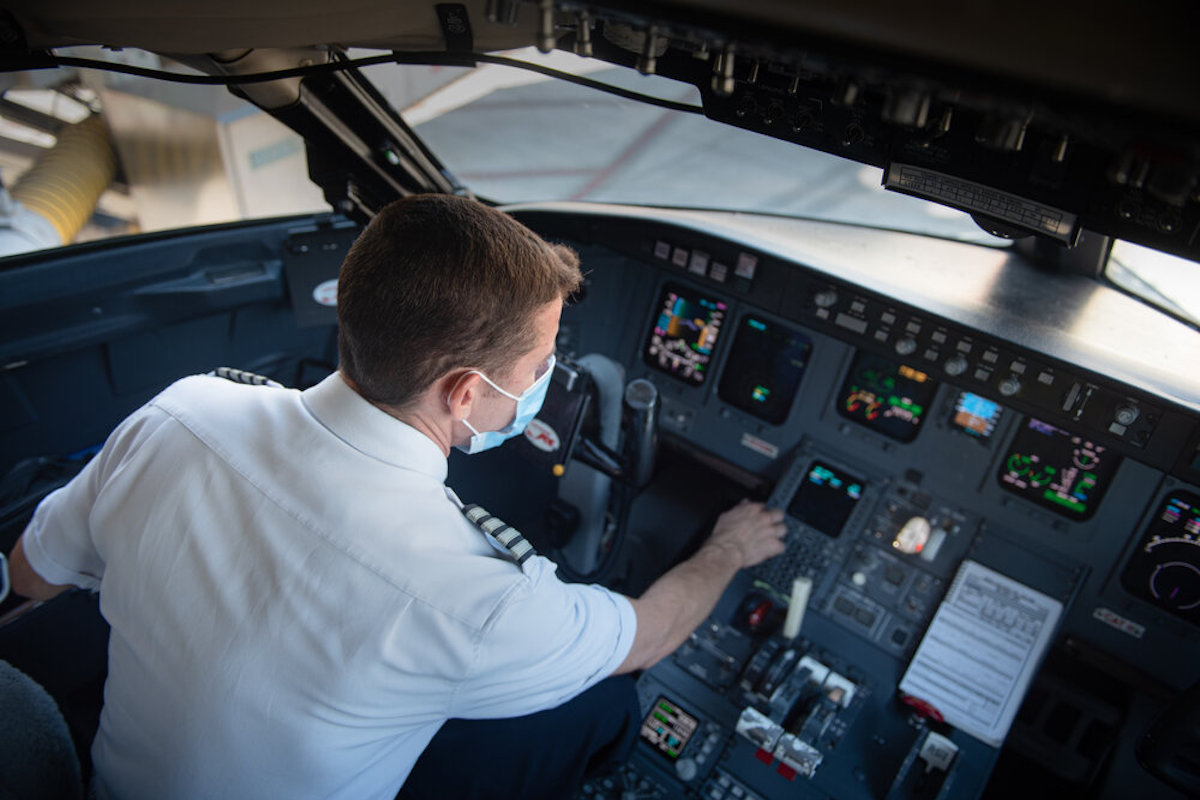Mesa Airlines Suspends Outlook as Pilot Attrition Weighs Heavy

Photo Credit: A Mesa Airlines pilot in the cockpit. Mesa Air Group
A year ago, regional carrier Mesa Air Group was flush with profits, even as many of the mainline carriers staggered from the evaporation of demand during the pandemic. But while the major airlines are now optimistic about the the rest of the year, Mesa is offering no guidance on balance of 2022 after its profits turned to losses.
The reasons for the reversal are many, CEO Jonathan Ornstein said, but two stand out: The end of federal government support for the airlines during the pandemic, and Mesa’s inability to hire and retain enough pilots. “Clearly, this quarter was very disappointing,” he said.
Throughout 2021, optimism abounded at Mesa. The regional launched a new cargo partnership with DHL to operate Boeing 737Fs, and planned to expand to up to 10 aircraft. It delved into electric aircraft. And it even had its sights set abroad, establishing a European subsidiary, Gramercy. At the time, Ornstein struck a rare positive note in the industry: “While 2020 has been a challenging year for the industry, we were pleased to remain profitable and cash flow positive throughout the pandemic,” he said in early 2021.
But then the government turned off the spigot of cash from the CARES Act and subsequent Covid relief packages. Last year, Mesa reported a $12.1 million adjusted pre-tax profit, thanks in large part to $66 million in federal payroll support. In its most recent quarter, Mesa reported an adjusted loss of $13 million.
Government funding was finite, and Mesa could plan for its end on Sept. 30 last year. But it couldn’t’ plan for the pilot shortage. The challenge facing Mesa this year, and for the near future is pilot attrition. The carrier does not have enough pilots to produce the block hours its mainline partners originally wanted, Ornstein said.
"We are going to see quite a bit of pressure in block hours through the rest of the fiscal year, and we expect them to be roughly flat over the next two quarters,” Chief Financial Officer Torque Zubeck said. “As we look at the summer and fall, we will continue to work closely with our partners to maximize block hours with a goal to at least maintain current production.”
The problem, according to Ornstein, is that during the pandemic about 4,000 mainline pilots took early retirement or left the industry. As a result, major carriers are now poaching talent from the regionals earlier in a person’s career than they would have before the pandemic.
The second issue is that Mesa can’t train new pilots fast enough to get them out on the line to complete its planned schedule, Ornstein added. The company has bought new simulators and is hiring flight instructors, both from outside Mesa and promotions from within. “I think we ultimately will be successful there so that we can then get the training capacity to outstrip the attrition levels,” Ornstein said. “We just need to make sure that we execute on that front.”
In other words, Ornstein said he is confident that Mesa can work through these problems this year, a year he said would be another one of transition. But he reserved his most scathing comments for the root cause of the pilot problem: Congress.
The 1,500-hour rule Congress mandated in the wake of the Colgan Air accident in 2009 is holding the industry back. Echoing his comments from the last quarterly call, Ornstein said it beggars belief that U.S. pilots are required to have 1,500 hours of experience before helming a commercial aircraft, while foreign pilots with far fewer hours of experience can fly a plane into the U.S. “I have probably the strongest feelings in the industry about it,” he said.
“This is all being generated by a rule that is totally unnecessary that's actually creating more velocity … more turnover,” Ornstein said. “That lack of stability in terms of the workforce has to have much, in my opinion, more serious effects than whether or not a person who spent 1,500 hours flying circles around the Pacific Ocean.”
But he doubted Congress would relax that rule. Republic Airways in April applied for an exemption to the rule, but regulators granting it is thought to be a long shot.
Ornstein also called on regulators to raise the mandatory pilot retirement age to 67, from 65 now, among other measures, like bringing in more pilots from abroad. “There's a lot of talk about pilots being able to be imported, qualified pilots from around the world,” he said.
Another challenge facing Mesa is its cargo business. In 2020 when it launched its 737F operation for DHL, Mesa had expected to grow to 10 or more aircraft in short order. It added its third 737F last month. “I think it's fair to say that we did anticipate being larger than three aircraft by now,” Ornstein said. Cargo operators tend to be more conservative in their growth plans, he added.
But Mesa does anticipate the segment to grow. It is sticking with an exclusive cargo partnership with DHL with no plans to branch out. The cargo operation also serves as pilot recruiting tool, offering new aviators a career path to mainline aircraft that other regional airlines can’t replicate. Executives offered no timeline on when the cargo fleet would expand.
The carrier is positive on its European subsidiary. It expects European certification later this year. “In Europe, there is no scope [clause] in Europe, and there are pilots available,” Ornstein said. “And I think that the American model of capacity purchase would do very well there.”
Mesa reported fiscal second-quarter operating revenues of $112 million, up from $97 million the previous year. Total operating expenses doubled to $167 million as capacity rose from last year. Maintenance expenses, which challenged Mesa last year, declined in the quarter.
